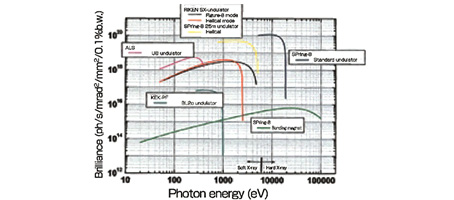
RIKEN Physics group is developing cutting-edge devices and applications using the most advanced light sources and optics available at SPring-8.
Applications at 1000m beamline
X-rays with high spatial coherence using a part of the central cone undulator radiation available on the 1,000-m beamline enable various types of coherent imaging techniques, including phase contrast imaging, x-ray holography and x-ray interferometry. RIKEN is also carrying out basic research on the mutual relations between photons and gravity using x-ray interferometry.
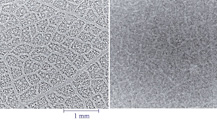
The illustrations show a refraction (left) and absorption (right) contrast image of a leaf. Medical x-rays are usually based on absorption, making it difficult to visualize soft tissues, where there is little difference between the absorption of x-rays by the different elements. By contrast, refraction contrast takes advantage of small differences in density, so it can be used for soft tissues.
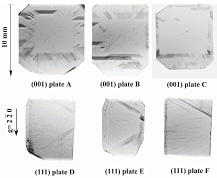
These x-ray diffraction images of synthetic diamond crystals taken with the large-size coherent X-ray beam on the 1,000-m beamline show lattice defects. High coherence large-area X-rays permit observation of lattice defects such as dislocations and stacking faults with high spatial resolution in a short time.
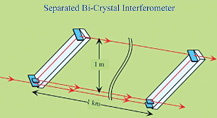
This large-scale separated x-ray interferometer permits measurement of the interactions between photons and gravity. Minute phase shifts can be seen between two x-ray beams passing through light paths at different heights.
Applications at 27m undulator beamline
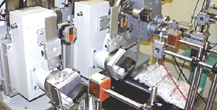
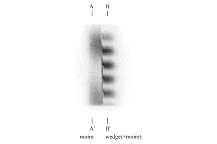
Various experimental techniques using x-ray interferometry are being developed for the 27-m undulator beamline that was completed in October 2000. Plans are underway for magnetic material investigation under a 15-tesla magnetic field and element-specific scanning tunneling microscopy for surface analysis based on non-linear optics studies that synchronize laser and synchrotron light. A completely separated bi-crystal X-ray interferometer, for the first time in the world ,was successfully operated at the beamline.

Research areas using soft X-ray beamline
A soft X-ray undulator beamline is under construction at SPring-8. This beamline will be used to study not only the fundamental elements for life such as oxygen, carbon, nitrogen, phosphorus, and silicon, but also other elements such as a transition or rare-earth-metals that are in common use in functional materials such as semiconductors. The basic objective is to study the electronic structure of substances such as semiconductors and superconductors as well as DNA and proteins which are vital to life, and to push forward basic research in the materials science, an area of extreme importance to humanity.
